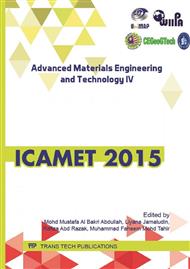p.388
p.395
p.400
p.405
p.412
p.416
p.421
p.426
p.431
Effect of Ultra High Molecular Weight Polyethylene (UHMWPE) as Binder and Sintering Temperature in Kaolin Geopolymer Ceramics on Flexural Strength
Abstract:
This paper present the flexural strength of kaolin geopolymer ceramics with addition of ultra-high molecular weight polyethylene (UHMWPE) as a binder. The effect of varying UHMWPE loading and different sintering temperature on kaolin geopolymer ceramics were evaluated. Kaolin and alkaline activator were mixed with the solid-to-liquid ratio of 1.0. Alkaline activator was formed by mixing the 8 M NaOH solution with sodium silicate at a ratio of 0.24. Addition of UHMWPE to the kaolin geopolymer ceramics are fabricated with UHMWPE loadings of 2, 4, 6 and 8 (wt. %) by using powder metallurgy method. The samples were heated at different temperature started from 900 °C until 1200 °C and the strength were tested. It was found that the flexural strength for the kaolin geopolymer ceramics with addition of UHMWPE were higher and generally increased with the increasing of UHMWPE loading. Similar trend was observed for the effect of sintering temperature. The result revealed that the optimum flexural strength was obtained at UHMWPE loading of 8 wt. % and the samples heated at 1200 °C achieved the highest flexural strength (49.15 MPa).
Info:
Periodical:
Pages:
412-415
Citation:
Online since:
May 2016
Price:
Сopyright:
© 2016 Trans Tech Publications Ltd. All Rights Reserved
Share:
Citation:


